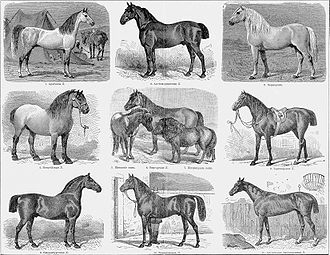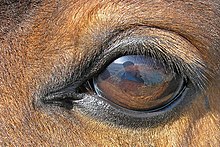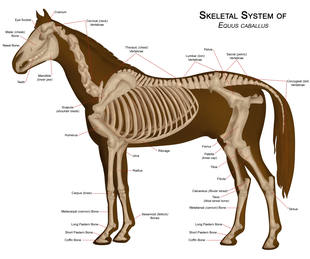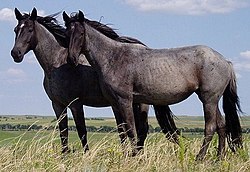See also: Horse sleep patterns and Sleep in non-humans
Horses are able to sleep both standing up and lying down. In an adaptation from life in the wild, horses are able to enter light sleep by using a "stay apparatus" in their legs, allowing them to doze without collapsing.[94] Horses sleep better when in groups because some animals will sleep while others stand guard to watch for predators. A horse kept alone will not sleep well because its instincts are to keep a constant eye out for danger.[95]Unlike humans, horses do not sleep in a solid, unbroken period of time, but take many short periods of rest. Horses spend four to fifteen hours a day in standing rest, and from a few minutes to several hours lying down. Total sleep time in a 24-hour period may range from several minutes to a couple of hours,[95] mostly in short intervals of about 15 minutes each.[96]
Horses must lie down to reach REM sleep. They only have to lie down for an hour or two every few days to meet their minimum REM sleep requirements.[95] However, if a horse is never allowed to lie down, after several days it will become sleep-deprived, and in rare cases may suddenly collapse as it involuntarily slips into REM sleep while still standing.[97] This condition differs from narcolepsy, although horses may also suffer from that disorder.[98]
Taxonomy and evolution
By about 15,000 years ago, Equus ferus was a widespread holarctic species. Horse bones from this time period, the late Pleistocene, are found in Europe, Eurasia, Beringia, and North America.[106] Yet between 10,000 and 7,600 years ago, the horse became extinct in North America and rare elsewhere.[107][108][109] The reasons for this extinction are not fully known, but one theory notes that extinction in North America paralleled human arrival.[110] Another theory points to climate change, noting that approximately 12,500 years ago, the grasses characteristic of a steppe ecosystem gave way to shrub tundra, which was covered with unpalatable plants.[111]
Wild species surviving into modern times
Main article: Wild horse
A truly wild horse is a species or subspecies with no ancestors that were ever domesticated. Therefore, most "wild" horses today are actually feral horses, animals that escaped or were turned loose from domestic herds and the descendants of those animals.[112] Only one truly wild horse species (Equus ferus) with two subspecies, the Tarpan and the Przewalski's Horse, survived into recorded history.The only true wild horse alive today is the Przewalski's Horse (Equus ferus przewalskii), named after the Russian explorer Nikolai Przhevalsky. It is a rare Asian animal, also known as the Mongolian Wild Horse; Mongolian people know it as the taki, and the Kyrgyz people call it a kirtag. The species was presumed extinct in the wild between 1969 and 1992, while a small breeding population survived in zoos around the world. In 1992, it was reestablished in the wild due to the conservation efforts of numerous zoos.[113] Today, a small wild breeding population exists in Mongolia.[114][115] There are additional animals still maintained at zoos throughout the world.
The Tarpan or European Wild Horse (Equus ferus ferus) was found in Europe and much of Asia. It survived into the historical era, but became extinct in 1909, when the last captive died in a Russian zoo.[116] Thus, the genetic line was lost. Attempts have been made to recreate the Tarpan,[116][117][118] which resulted in horses with outward physical similarities, but nonetheless descended from domesticated ancestors and not true wild horses.
Periodically, populations of horses in isolated areas are speculated to be relic populations of wild horses, but generally have been proven to be feral or domestic. For example, the Riwoche horse of Tibet was proposed as such,[115] but testing did not reveal genetic differences with domesticated horses,[119] Similarly, the Sorraia of Spain was proposed as a direct descendant of the Tarpan based on shared characteristics,[120][121] but genetic studies have shown that the Sorraia is more closely related to other horse breeds and that the outward similarity is an unreliable measure of relatedness.









